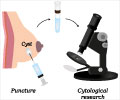Scientists at Albert Einstein College of Medicine of Yeshiva University have revolutionised the field of breast cancer study by describing a method of viewing individual breast cancer cells for several days at a time.
Called 'photoswitching', the method according to scientists in Einstein's Gruss Lipper Biophotonics Center, can provide detail on how cancer cells invade surrounding tissue and reach blood vessels, which is the first step of the potentially deadly stage of cancer known as metastasis."Photoswitching can be done inside a living mouse which enables monitoring cell paths over days," Nature quoted the authors as saying.
Unlike earlier methods, which only allowed cells to be viewed clearly for several hours at one time, the new method actually provides a clear view of cancer cells over several days in their natural environment.
Having a longer and clearer window into how cancer cells move during the early stages of metastasis may ultimately lead to the development of effective cancer therapies.
By using intravital imaging, the researchers developed a "photoswitch" to mark cancer cells of their choosing within a tumour and study how these tumour cells in mice move in their surrounding tissue.
With the technique, the researchers could see individually labelled tumour cells move in real time and in living mice.
Advertisement
Viewing the cells through the window using a microscope, allows the researchers to see how the cells spread.
Advertisement
The cancer cells near blood vessels also appeared in the lung indicating that they are disseminated throughout the body.
Co-lead author, Bojana Gligorijevic Ph.D., explained: "Our work showed how important the microenvironment of a tumour is to the behavior of a cancer cell and the metastatic outcome of the tumour itself. We can now look at the early steps of metastasis in high resolution and specific regions of the tumour."
For the first time, a study has shown a direct link between the presence of blood vessels and the invasive ability of a cancer cell, which strengthens the growing theory that blood supply is crucial to effective metastasis.
Also, the findings of the study suggested that cancer therapies undergoing development, which are directed at cutting off blood supply to tumours, may hold future promise for treating breast cancer.
The study is appearing in advance online publication of Nature Methods.
Source-ANI
SRM














